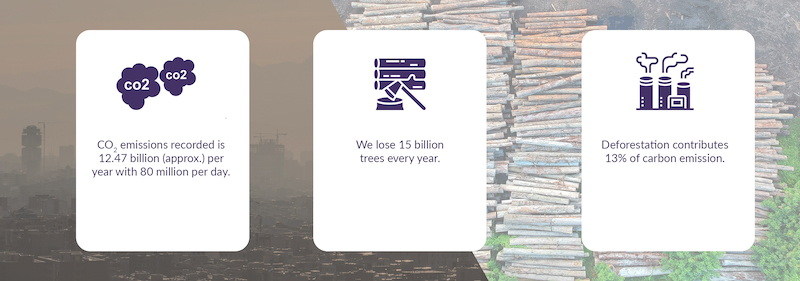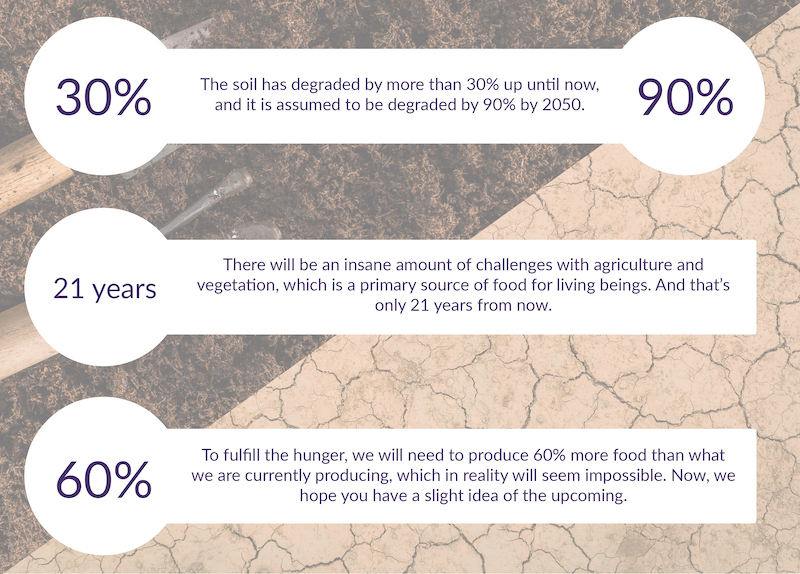Do you think you have the power to change the world? Can you become a superhero? Or will you, like every villain destroy the planet? You can choose your sides, but remember your actions have heavy consequences. Read more to figure out which side are you on.
Ecosystems and their biodiversity still hold the key to life on this planet. We all are bound by an infinite network where every species depends on another species to survive. Humanity will soon face one of the greatest challenges. And we all know the root, the problem is clear. The biggest problem that our planet Earth is facing right now is climate change and global warming. It’s caused by an increase in Carbon Dioxide in the atmosphere. We need to limit and reduce our emissions and draw the existing carbon out of the atmosphere.
You might think of yourself as a mere human, and what you could do alone to create any change. If people were to invest their valuable time and energy, they need to comprehend the size of opportunities and understand the impacts we can have as an individual. We are facing so many problems, but the solution is the same: we start restoring the ecology.
What better day to take your first step in the attempt of restoring our earth? World Earth Day is marked on 22nd April every year and this year celebrating its 51st anniversary. This day is celebrated to create awareness among the general people regarding the significance of environmental protection. Every earth day is assigned with a theme and this year’s theme for International Earth Day 2021 is Restore Our Earth. This year will be more focused on self-reflection and the implementation of ways to restore and revive the damage we have caused.
Embarking on World Earth Day, Felt and Yarn would want to create awareness and spread the importance and benefits of the restoration of Earth. We are also thriving and working towards setting an example that green companies are possible and are very sustainable. So, What is a green company? What makes you a green company? And how can you become one?
Green businesses strive to better the lives of their consumers, workers, communities, and the world by engaging in socially and environmentally responsible ways. This means taking specific measures to ensure that their facilities do not pollute the air and water. Those are only terms and definitions; what is hoped for is to take measures to put them into effect. So, let us discuss why we call ourselves a green company and what you can do to become one.
What would you do if there is no drinking water by 2050?

Despite significant attempts to treat and clean up wastewater, water contamination has reached concerning levels in recent years. Each year, humans add 1.2 trillion gallons of untreated wastewater to the world's water supply. Furthermore, each year, 17.6 billion pounds of plastic were poured into the ocean.
If we continue to pollute our planet at the same pace, nearly half of the world's population will be unable to find safe drinking water by 2050. Water pollution impacts human health and the atmosphere poses significant threats to humanity's survival on our planet.
1.3 million gallons of oil are spilled into the water
The contamination of water in the ecosystem by chemicals and heavy metals has very harmful effects on aquatic life. This contaminant is known to be implicated in the reduction of an organism's life span and ability to reproduce. To such extent that until last year, 2020; 415 dead zones were recorded. Dead zones are marked water bodies where aquatic animals are not able to live. It is not an unknown fact that all the waste and sewage are dumped into water bodies. Water pollution by oil is also a major factor that is threatening our water resources. 1.3 million gallons of oil are spilled into the water.
What are we doing?
Running a felt company, with water being a requisite for the felting technique - consumption of mass water resources was inevitable. The manufacturing demanded 1500 liters of water per day which was quite challenging and the company had to find efficient ways to save water resources. That is when we came up with an innovation of water harvesting and reusing.
Our project started with laying down the gutters and downpipes to collect and use the rainwater. During the monsoon, we can harvest up to 2 lakh liters of rainwater using the rainwater harvesting method. So we have installed filters in rainwater drain pipes that have an amazing self-cleaning mechanism.
Additionally, the next project was to be able to continue to reuse the water to reduce water consumption. All the water used for felting gets collected and then sent for filtration. We use rapid sand filters as an alternative use of harsh chemicals to filter the water. This is accompanied by a customized rapid sand filter composed mainly of layers of filtration system that eliminate the residual dirt and debris while also reducing bacteria.
With such implementation, we are successful and can conserve up to millions of liters. The investment for the water-saving project was worth it as currently, we are saving up to 250 dollars per month for not having to buy water.
Felt and Yarn also use Azo-free dye. Unlike every harsh chemical, Azo is one of the most commonly used dyes in textile industries, which has a huge contribution to water pollution. The chemical used is so potent that it can cause severe damage to the only cats, but humans too. It has been recorded that any vulnerable living beings exposed to such poisonous dye can cause major health issues such as cancer, kidney failure, aromatic amines, and even death.
Few facts about the current situation for you to understand the chaos that our actions result in. Soil is the land we all live on and are so dependent i.e. directly related to our survival. The soil has degraded by more than 30% up until now, and it is assumed to be degraded by 90% by 2050. There will be an insane amount of challenges with agriculture and vegetation, which is a primary source of food for living beings. And that’s only 29 years from now. The population of humans keeps increasing at a fast rate, more people equals more need for food. To fulfill the hunger, we will need to produce 60% more food than what we are currently producing, which in reality will seem impossible. Now, we hope you have a slight idea of the upcoming.
Have we been breathing in oxygen or poisonous gas?

When the air becomes contaminated with poisonous gas and other particles creates a threatening event for the health of all living organisms and the environment. Earth can fulfill the livelihood satisfaction of humans, but it can’t fulfill the greed of humans. Most air pollution is the result of human impact on the environment. With modernization and the era of industrialization, planet Earth has been suffering the most. The CO2 emissions recorded is 12,477,800,132 (approx.) per year with 80,000,00 per day. This leads to a rise in global temperatures which creates a cycle where air pollution leads to climate change. The main source of emissions is the combustion of coal, natural gas, oil, and other fuels, including industrial waste and non-renewable waste.
Do we not deserve rainforests? No rainforest after 80 years
Our planet's forest is one of the most valuable resources available. They source our air, food, construction material, and much more. Even more importantly, forests are our strongest defense against climate change. A single tree can absorb up to 48 pounds of carbon dioxide each year. Capturing decades of human emission.
Despite their significance, forests are systematically being destroyed over the years. That is what we call deforestation. Each year, we lose 15 billion trees worldwide, and are accelerating. At this rate, we might no longer have a rainforest in the next 80 years. Which makes deforestation have a huge contribution of 13% of carbon emissions. All of these are driven by our relentless economic expansion and population growth both set to continue increasing dramatically.
What are we doing?
Every product produced in Felt and Yarn is completely biodegradable and renewable. Our main textile being felt, has tons of benefits to the environment which we will be going into detail about later on.
None of the manufacturing processes contributes to any air pollution. Our felting techniques are harmless to the earth and we try to do it in the most efficient way to conserve as many resources as we can.
We are focusing on replacing the use of toxic materials such as plastics and wood for decor. Encouraging more and more people to start using eco-friendly products in replacement to the nonrecyclable products which are burned. Burning waste is a common means of diminishing waste but harms the environment.
The usage of plastics is unavoidable. The material is very useful and easily accessible; making humans very dependable. To try to combat reducing the use of plastics, our company ensures to use of plastics that are only above 150 microns. Besides being slightly expensive, Felt and Yarn also invest in bioplastics to try to minimize plastic waste.
One of the major causes of deforestation is for creation of paper. Papers are stable stationery in every household. Papermaking has an adverse effect on the ecosystem because it eliminates trees in the process. As per data from the Global Forest Resource Assessment, nearly 80,000 to 160,000 chopped down per day around the world, with a substantial percentage being used in the paper industry. Contributing more than 20% of air pollution and water pollution.
Felt and Yarn have for years supported a local manufacturing company that recycles paper. The recycled paper has a unique texture and color which is very charming and serves a great purpose for gift cards. Every gift card received from our company attached to your order is made out of 100% recycled paper. Not only contributes to the planet but also helps in building a sustainable community and reinforcing job opportunities for Nepali society.
Almost 18,000 people die each year.

Even as renewable energy is becoming more common, so-called "dirty energy"—coal, oil, and natural gas—continues to provide the majority of our electricity and fuel. Approximately 80% of the electricity and primary energy is produced from non-renewable sources.
According to the European Environment Agency, the use of fossil fuels for heating, power, transportation, and manufacturing accounts for about two-thirds of global greenhouse gas emissions. In 2015, energy accounted for 78% of gross greenhouse gas emissions in the European Union.
However, for many others, being fully self-sufficient in renewable energy is a pipe dream.
The facts and statistics on the effects of low air quality are alarming. According to the International Energy Agency's special study report on global energy, almost 18,000 people die each day as a result of air pollution.
Energy generation is the source of the most air pollution. Dirty energy also harms our climate in several respects. Although both energy sources affect the climate, fossil fuels/dirty energy is more harmful than green energy. This covers water waste, biodiversity, and habitat destruction, as well as all of the environmental consequences of global warming.
What are we doing?
Felt and Yarn have installed solar panels all over the manufacturing factory and every ounce of electricity used are through solar panels. With an additional attempt to save energy by using natural water harvesting methods and renewable electricity sources.
We will make a huge difference by switching to more alternative energy sources, such as wind, solar, hydroelectricity, and geothermal, and lowering greenhouse gas emissions and pollution.
Why opt for wool craft items better than other craft items?
Wool is completely biodegradable and therefore does not lead to microplastic waste in our oceans or on our soil.
Wool fibers have natural characteristics that make them superior to synthetic fibers. Wool materials are more durable, needless regular washing at low temperatures, are easily recyclable, biodegradable in both soil and water and do not lead to microplastic waste. Microplastic waste is increasing alarmingly in our seas, with 20 percent to 35 percent of microplastics in the water being generated from washing clothing. Wool is completely biodegradable, therefore it does not lead to microplastic waste in our oceans or on land.
Wool consumes 18% less energy than polyester and almost 70% less water than hemp.
Synthetic fiber products can take up to 40 years to degrade, while wool, a natural fiber, degrades in a fraction of that time. Wool is composed of keratin, a natural protein similar to that found in human hair that can be broken down spontaneously without posing an environmental risk.
And wool will also reduce waste to landfill as it decomposes in the soil in a matter of months or years, whilst slowly releasing valuable nutrients back into the earth and is an incredibly effective soil fertilizer. This provides a compelling statement, notably when we acknowledge that wool's natural properties allow for less frequent; lower-impact washing, and provide greater durability.
Upcycling our felt waste
While creating felt products, it is not uncommon to have excessive felts. The bits and pieces are not adequate to create any other felt project and will leave no other option but to throw them away. To minimize the waste, Felt and Yarn have initiated using the scraps in a new innovative Recycled felt product.
What is “Ethically” sourced wool?
Many people are making new attempts to be environmentally sustainable and engaging in more responsible sourcing practices in an environment that is rapidly evolving and responding to new developments. But what exactly do we mean by this? And why should we be concerned with responsible sourcing or the origins of our products?

Ethical sourcing is the method of ensuring that materials are obtained responsibly and sustainably, that any environmental damage is considered, and that the people engaged in their production are treated appropriately and securely.
Is shearing animal cruelty? Or necessity?
There are many misconceptions floating around that shearing could be a form of animal cruelty. We are here to debunk and change your mind. Shearing if done ethically and properly, is essential for each sheep's health and hygiene. Many sheep, unlike other species, are unable to shed. Every sheep needs to be sheared twice or at least once annually or else it will result from the sheep with many difficulties. Having to carry heavy matted wool, making them unable to see, move and walk properly. It also can cause skin diseases which may even result in death.
Felt and Yarn imports wool from the highlands of New Zealand that also only from licensed and registered suppliers. Sheep in New Zealand are raised on ethical farms. They are also provided with adequate shelter and treatment. Sheep that are raised on ethical farms are shorn once a year as well. This strikes a balance between the need for wool volume and the importance of wool quality.
And, once again, the sheep are handled with the utmost respect. The New Zealand Animal Welfare Act of 1999 governs the farms to ensure appropriate behavior and any animal ill-treatment cases found in New Zealand will be fined from $50,000 to $100,000. And New Zealand is one of the first countries to make Mulesing illegal.
What you should do?
The ecosystem is much bigger than planting trees. Trees are just the symbol of entire ecosystem restoration. The restoration of nature is for the local biodiversity and community that depends on it. And as we all start taking initiative, collective action benefits everyone.
Global restoration is not easy. Understanding the existing crisis and it is the responsibility of every human being on this planet to take initiative and be the change.
Start with reducing your activities that could harm the environment. Limit your plastic uses, and support green companies and companies that produce biodegradable and sustainable solutions. We need to end the era of fuels to protect our nature and land.
We have needed knowledge and technology to realize it makes social and economic sense. And when we succeed, we can take a lungful of fresh air. We will wake up to healthier lifestyles and resilient ecosystems in livable cities. We are all on this journey around the sun altogether. This is our only home. A healthy planet is not an option, but a necessity.
So what are you doing to reduce Climate Change to Save Earth and restore our planet? We are excited to hear about the steps that you take to change the world. We can surely learn something valuable from you. Comment down below!
